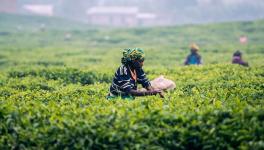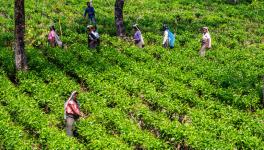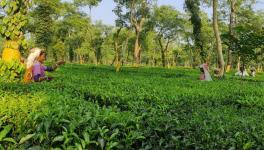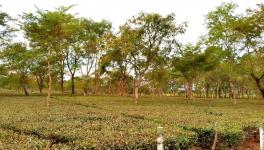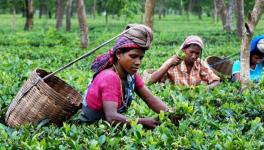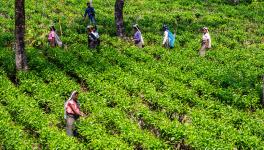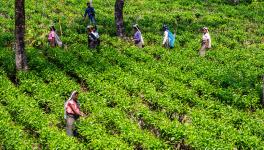Your Morning Tea May Get Costlier....Or Maybe Not
Kolkata: The tea industry in Assam and West Bengal, which is estimated to have recorded a fairly sizeable decline in production compared with 2019 due to uncontrollable circumstances, is banking on the next three months -- August, September and October— the traditional heavy cropping period in North India.
First, garden activity had to be completely suspended from late March when a sudden lockdown was imposed country-wide by the Union government to contain the COVID-19 pandemic. Subsequently, despite the lockdown being in force, resumption of garden work was officially allowed on a restricted scale.
At a later stage, normal activity was allowed, subject to tea garden managements ensuring adherence to prescribed safety norms. By the time normalcy returned, about a month’s production had been lost. The next reason causing a setback to garden operations for several days at a stretch, was floods in Assam and heavy rains in North Bengal.
The Tea Board’s provisional estimates show production in four months till April in North India at 57.64 million kg (mkg), against 70.47 mkg in the corresponding period of 2019. The monsoon has had a very active start, and late June onward, and even now, floods in Assam and torrential rains in North Bengal have disrupted usual activity in the gardens. While official estimates are not available, the industry apprehends that the crop decline may have accentuated.
This situation has prompted the Tea Research Association (TRA), which had issued special advisory on agricultural practices to be followed in the lockdown phase, to once again prescribe dos and don’ts in the given circumstances.
The advisory lays down action points to deal with problems arising from silting, choked drainage and higher incidence of pest attack. Application of manure and foliar nutrients and precautions to be taken before plucking is resumed is among other action points detailed by TRA.
This approach has to be decided taking into account the duration of floods – up to three days and beyond three days. If the soil remains submerged for more than three days, tender shoots show signs of wilting and thereafter, the leaves start falling off.
According to TRA secretary Joydeep Phukan, the initial loss in output was because of overgrowth skiffing in April and May and thereafter, serious damage was caused by floods in Assam and often incessant rains in North Bengal. The situation is expected to improve from August, Phukan told NewsClick.
The effect of the apparently sizeable decline in output is visible in tea auction prices, which have firmed up considerably. In the North India auction centres, sales showed a fall of 36% to 47.14 mkg between June 1 and July 18. In the corresponding period of 2019, sales stood at 63.58 mkg. The average price for the week ending June 6 last year was Rs 158.48 per kg. This time the price spurted nearly 39% to Rs 218.97 a kg. For the week ending July 18 last year, the price was Rs. 169.22 a kg. This year, the price was nearly 60% higher at Rs 270.24.
“The price upswing seen thus far has occurred after a fairly long time,” J Kalyana Sundaram, secretary of Calcutta Tea Traders Association, told NewsClick.
Also read: COVID-19 in Rural India-XXX: Impact of Lockdown on Tea Plantation of Thettamala, Kerala
A section of tea traders, however, is not sure whether the higher price levels are sustainable. Much will depend on the heavy cropping months of August, September and October. Last year, in these three months, North India registered a production level of 478.17 mkg, which was 41% of North India’s total of 1,171.09 mkg. The significance of this period is thus obvious.
But, there are others--in the thick of the tea trade--who are inclined to believe that the deficit, if it is large, is unlikely to be made good even if the August-October period delivers, as under normal circumstances. They say the ground reality will be known only early next year.
But, available pointers suggest that the authorities are unlikely to face the type of delicate situation that crops up when there is scarcity of onion and sugar. This is because of the balancing factors already at work.
The total and restricted lockdown phase, which began suddenly on the midnight of March 24-25, and has now crossed four months, has seen a perceptible drop in out-of-home tea consumption; mainly at roadside tea stalls, hotels and restaurants. In the assessment of chairman of the Federation of All-India Tea Traders Associations (FAITTA) Viren Shah, this factor alone has led to a domestic consumption drop of 25-30%.
“It is possible that confinement at homes may have driven people to drink an extra cup or two of tea, but this cannot be generalised and, therefore, this factor can only have a marginal compensatory impact on the fall in out-of-home tea consumption,” said Shah, while speaking to NewsClick from Surat, where his company Jivraj Tea Ltd is located.
“Moreover, in a bid to strengthen their immunity, people are consuming ‘kadha’, a beverage prepared with cloves, whole pepper ginger, palm candy and some other spices. There is evidence of this habit catching up in many places,” he added.
The executive director of Ahmedabad-based Wagh Bakri Group, Parag Desai, too, subscribed to the assessment that domestic consumption has seen a decline during the lockdown.
Wagh Bakri, which has major presence in the tea trade, operates 13 tea lounges and nearly 100 tea kiosks. These had to suspend business as soon as the pan-India lockdown was enforced.
Nudged by the state government, Wagh Bakri resumed business a week ago. Despite the resultant revenue loss, the company paid the staff their full salary, Desai told NewsClick. He sees the year closing with production lower, may be substantially, than 2019.
Also read: In Assam, Tea Production Record High, Show Cause Notices Served
The other balancing factor is most likely to be exports. Many of the importing countries are still continuing their fight against the pandemic and there are yet no clear indications when the disease will subside, permitting normal import-export trade. Tentative estimates for January-March 2020 show exports from North India at 32.47 mkg, against 39.57 mkg for the same quarter of 2019.
It’s too early to make back-of-the envelop calculations regarding the likely level of exports, but the possibility of a noticeable decrease cannot be ruled out at this juncture, according to secretary of Indian Tea Association, Sujit Patra.
The FAITTA chairman added that he had received reports of Kenya’s CTC (crush, tear, curl) tea production showing a marked uptrend, which is also borne out by a decelerating price trend in that country. Therefore, some importers of India’s CTC tea sourcing a certain quantum of the Kenyan product on price considerations, need to be factored in, according to Shah.
Meanwhile, much to the relief of tea garden workers and their trade unions, the incidence of COVID-19 has remained well under control since operations were stepped up gradually. Only a few cases have been reported in Assam and the management promptly took remedial measures.
Before garden activity was resumed on a restricted scale, “We had insisted that it would be the management’s responsibility to keep all protective facilities in a state of readiness,” general secretary of Assam Cha Mazdoor Sangha (ACMS) Rupesh Gowala said. There is no panic among the workers about the disease.
On July 2 a “satisfactory” wage revision agreement for nearly 40,000 supervisors was successfully negotiated through video conferencing between ACMS – affiliated to Indian National Trade Union Congress -- and the garden owners’ umbrella organisation, the Consultative Committee of Plantation Associations, Gowala told NewsClick over phone from Dibrugarh.
“We have been closely monitoring the situation since resumption of operations. With limited space in their dwelling units, we ruled out home quarantine if any case of infection was detected. Luckily for us, the situation has not caused us concern. Only a few cases were detected and prompt remedial steps prevented spread of the disease,” working president of Darjeeling District Chaya Mazdoor Union, Saman Pathak, told NewsClick.
Pathak, who is a former Rajya Sabha member and currently district secretary of the Communist Party of India (Marxist) affiliated Centre of Indian Trade Unions, said in the vast expanse of the tea gardens, enforcement of physical distancing norms is not a problem at all. But, the very limited space in the dwelling units cannot be conducive for home quarantine.
“We had, therefore, asked the management to make alternate arrangements that are in consonance with prescribed norms. We organised strict monitoring and we are happy to find that it has worked,” Pathak said. However, he lamented that “not much could be done to alleviate the workers’ financial distress”.
Also read: COVID-19 and Closed Tea Gardens: Issues of Livelihoods in India
The writer is a freelance journalist based in Kolkata.
Get the latest reports & analysis with people's perspective on Protests, movements & deep analytical videos, discussions of the current affairs in your Telegram app. Subscribe to NewsClick's Telegram channel & get Real-Time updates on stories, as they get published on our website.









